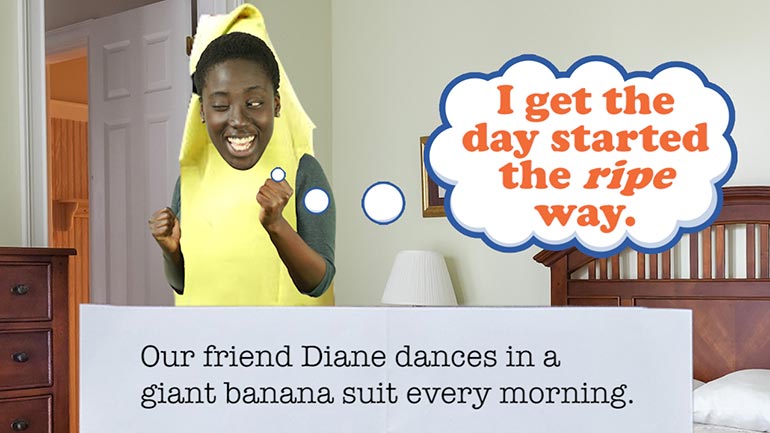ShmoopTube
Where Monty Python meets your 10th grade teacher.
Search Thousands of Shmoop Videos
Science 4: Drum Messages 11 Views
Share It!
Description:
Humans used to use drum beats instead of texting each other before cell phones existed. It was rough, but at least you got some musical training done while you messaged people.
Transcript
- 00:04
[Dino and Coop singing]
- 00:13
One of the main roles of drumming in our society is to
- 00:16
make parents regret every decision they've ever made. [Parents walking away and closing the door]
- 00:18
Seriously, buying a drum kit as a birthday present? [Kid playing the drums]
- 00:20
Always a dangerous game.
Full Transcript
- 00:22
But in some societies, drums provided a great way to communicate, through appropriately [Someone playing a bongo drum]
- 00:26
named "drum messages."
- 00:27
But…why drums?
- 00:29
Why not just talk…
- 00:30
…or use sign language…
- 00:32
…or even pass notes? [A paper plane hits a girl in the head]
- 00:33
Though we don't recommend doing that last one in class, unless you're a big fan of detention. [Student passes someone a note in class and gets sent to the principals office]
- 00:37
Well, the greater the distances between people, the harder it is to communicate. [Student with his thumbs up]
- 00:41
Sure, you might be able to yell across a soccer field to a friend… [Man shouting to his friends]
- 00:44
…but once you get a few miles away from each other, you're out of luck.
- 00:47
At that point, the only message you'll be communicating is: "I'm very loud!" to people [The man's friends drive off and he is still shouting]
- 00:51
walking past you.
- 00:53
These days we have cellphones to solve this problem, but they're a pretty new innovation. [An arrow is shot into a cellphone]
- 00:56
And that's where drums came in.
- 00:58
To send a message using a drum, we first need to make a drum.
- 01:02
We start with a big log. [Chainsaw chopping a log]
- 01:03
The bigger the log is, the louder our drum will be.
- 01:06
Then we cut a big slit in the side of the log, and use that slit to hollow it out.
- 01:11
The more the log is hollowed out, the deeper the sounds it'll make. [Hollowed out log]
- 01:14
So if you like low tones, prepare thyself for big piles of wood chips.
- 01:17
And we definitely don't recommend wood chip angels. [Girl making an angel in a pile of wood chips]
- 01:20
They're not nearly as fun as you might think….ouch… [Girl gets lots of splinters in her arms]
- 01:24
Once the drum is complete, it can be used to communicate! [A sparkling new drum]
- 01:26
…Great, we forgot what message we wanted to send. [Guy looking confused]
- 01:29
All that work for nothing.
- 01:30
But for the people who remembered what they wanted to say, they would use sticks to beat
- 01:33
out a specific rhythm on the drum… [Woman playing a drum]
- 01:36
…and then people miles and miles away would hear that rhythm and know that grandma was
- 01:39
saying hello!
- 01:40
Or…whatever the message happened to be. [Girl looks happy]
- 01:42
Different beats would mean different things, so people miles away wouldn't just be hearing
- 01:45
a cool rhythm: they'd be hearing a clear message. [Woman at a BBQ listening to the drum message]
- 01:48
And if that rhythm happened to make people really want to dance, well, that was just
- 01:51
an added bonus. [People dancing]
- 01:52
This drumming produces sound waves that can be heard at distances of up to seven miles away. [Coop pointing at a blackboard]
- 01:57
However, the range of these messages could be extended even more by sending the message
- 02:00
to one village…
- 02:01
…which then sends it again, so even more villages can hear it. [Woman listens to the message and then plays it]
- 02:05
Pretty good for a telecommunications network made entirely of wood.
- 02:09
Hm…we wonder why pine satellites never really took off… [Log floating in space]
Up Next
Sticks and stones, right? Well...only sometimes. It's a good idea to make sure your words aren't going to hurt others. Let's look at some ways to d...
Related Videos
Learn to debate like a champ. It's way better than debating like a chimp. That just takes mudslinging to a whole new level.
Today we'll learn about biographies and autobiographies. And no, the second one has nothing to do with the lives of cars.
In this lesson we'll subject you to some verbs and predicates. Each one is a necessary part of a complete breakfas—er...sentence.
Choosing words carefully is important. You may end up vexing the assemblage of citizens you're conversing with...or you might even just plain bore...




